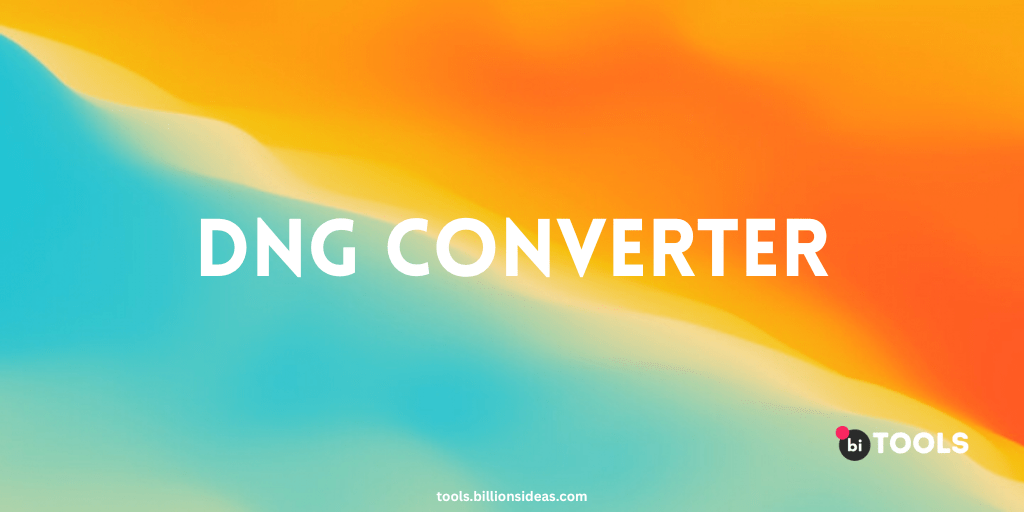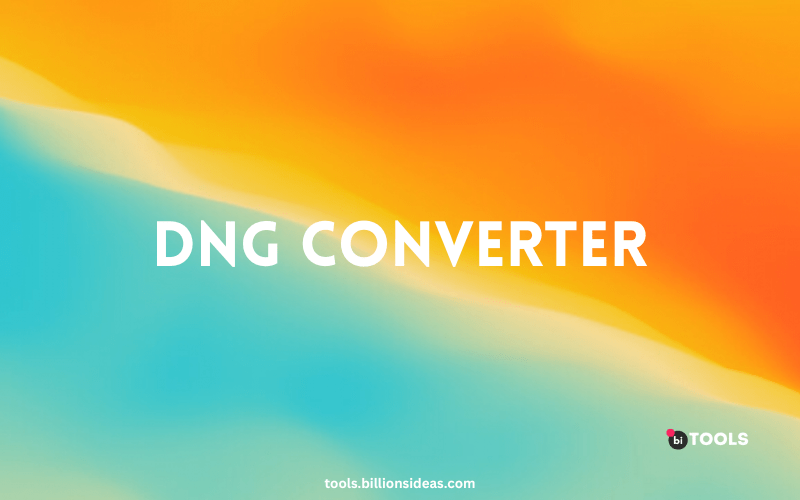DNG Converter
PNG, JPG, JPEG, WEBP, ICO, BMP, AVIF, TIF, TIFF, GIF, BIN to DNG Converter

As professional photographers, we know that the quality of our work depends on several factors, such as lighting, composition, and editing. However, one of the most critical components of our workflow is the conversion of raw image files into a usable format. While there are several file formats to choose from, DNG (Digital Negative) has become increasingly popular over the years due to its flexibility and compatibility with various software applications.
In this article, we will explore the importance of using a good DNG converter in your photography workflow and how it can help you produce high-quality images that stand out from the competition.
Contents
What is a DNG Converter?
A DNG converter is a software tool that converts raw image files from your camera into the DNG file format. The DNG format was developed by Adobe to provide a universal format for raw image files that is compatible with different software applications. This format provides several benefits, such as reduced file size, increased speed, and compatibility with older software applications. It allows you to store all the original data captured by your camera, including the color information, the brightness, and the contrast, in a lossless format. This means that you can preserve the highest quality of your original image files without any degradation.
Why Use a DNG Converter?
Using a DNG converter offers several benefits that can help improve your photography workflow. Here are some of the key advantages of using this converter:
- Compatibility: DNG files are compatible with various software applications, including Adobe Photoshop, Lightroom, and Camera Raw. This compatibility means that you can work with your images in any of these applications, regardless of the camera brand you use.
- Reduced File Size: Converting your raw files to DNG format can reduce the file size by up to 20%, which means you can store more images on your hard drive and memory cards.
- Increased Speed: DNG files are smaller in size than raw files, which means that they can be processed and edited faster. This increased speed can help you save time in your workflow, allowing you to focus on other important aspects of your photography.
- Future Proofing: Using DNG format ensures that your images will be compatible with future software applications, even if the manufacturer of your camera ceases to support the raw file format.
How to use a DNG Converter?
- Download and install the DNG converter software on your computer. Adobe provides a free DNG converter that you can download from their website.
- Open the DNG converter and select the raw image files that you want to convert.
- Choose the location where you want to save the converted DNG files.
- Select the conversion settings. You can choose to preserve the original color profile, the exposure settings, and the metadata, or you can apply new settings.
- Click the Convert button to start the conversion process.
- Once the conversion is complete, you can open the DNG files in any photo editing software, such as Adobe Photoshop, Lightroom, or Capture One.
Benefits of using a DNG converter
Now that you know the benefits of using this converter, it’s essential to choose the right one for your needs. Here are some factors to consider when selecting this type of converter:
- Compatibility: Make sure that the DNG converter you choose is compatible with your camera’s raw file format. Some of these types of converters may not support certain camera brands or models, so be sure to do your research before making a purchase.
- Speed: Look for a DNG converter that can convert your files quickly and efficiently, without compromising the quality of your images.
- Features: Consider the features that this converter offers, such as batch processing, metadata editing, and color correction. These features can help streamline your workflow and improve the quality of your images.
- Price: While some may be more expensive than others, it’s important to choose a tool that provides the features and quality that you need for your photography workflow.
Tips for Using the DNG Converter
Here are some tips to help you get the most out of the DNG Converter:
- Use the latest version of this Converter to ensure that you have all of the latest features and bug fixes.
- Convert your files to DNG as soon as possible after capturing them to ensure that you don’t lose any data during the editing process.
- Choose the options that best suit your needs when converting your files, such as file format, resolution, and compression.
- Remember that DNG files are still raw files, so you’ll need to edit them in a software application that supports raw files.
Best online DNG converter tools :
- Adobe DNG Converter: This is the official DNG converter developed by Adobe. It is available for both Windows and Mac, and it can convert a variety of raw image formats to DNG.
- BI Tools: This is another online converter that supports raw image formats, including CR2, NEF, and ARW. It can convert these formats to DNG and also offers some customization options such as image quality and DPI.
- Online-Convert: This is a web-based converter that supports a wide range of file formats, including raw image formats like NEF, CR2, and ARW. It can convert these formats to DNG, and it also offers some customization options such as image size and quality.
- Convertio: Convertio is another web-based converter that can convert raw image formats to DNG. It supports a variety of input formats and also offers some editing options such as image rotation and cropping.
Conclusion
Using a good DNG converter is essential for any professional photographer who wants to produce high-quality images that stand out from the competition. Not only does it offer compatibility with different software applications, but it also provides reduced file sizes, increased speed, and future-proofing for your images.
When choosing a DNG converter, make sure to consider factors such as compatibility, speed, features, and price to ensure that you select the right tool for your needs. By incorporating a DNG converter into your photography workflow, you can streamline your editing process, save time, and produce images that truly showcase your skills as a photographer.
FAQ
What are the benefits of using a DNG Converter?
Using this Converter offers several benefits, including increased accessibility, smaller file sizes, and a simpler workflow. Additionally, DNG files are compatible with a wide range of image editing software, making them a versatile choice for photographers.
Can DNG Converter convert other file formats besides RAW?
No, this Converter is specifically designed to convert RAW files to the DNG format. If you have other file formats that you wish to convert, you will need to use a different software tool.
Does DNG Converter support batch processing?
Yes, DNG Converter does support batch processing. This allows you to convert multiple files at once, saving time and simplifying your workflow.
How do I download and install DNG Converter?
DNG Converter can be downloaded for free from the Adobe website. Simply navigate to the download page, select your operating system, and follow the prompts to download and install the software.
